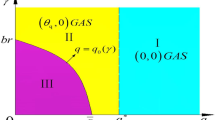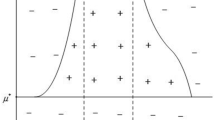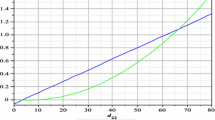Abstract
This paper deals with a system of reaction–diffusion–advection equations for a generalist predator–prey model in open advective environments, subject to an unidirectional flow. In contrast to the specialist predator–prey model, the dynamics of this system is more complex. It turns out that there exist some critical advection rates and predation rates, which classify the global dynamics of the generalist predator–prey system into three or four scenarios: (1) coexistence; (2) persistence of prey only; (3) persistence of predators only; and (4) extinction of both species. Moreover, the results reveal significant differences between the specialist predator–prey system and the generalist predator–prey system, including the evolution of the critical predation rates with respect to the ratio of the flow speeds; the take-over of the generalist predator; and the reduction in parameter range for the persistence of prey species alone. These findings may have important biological implications on the invasion of generalist predators in open advective environments.





Similar content being viewed by others
References
Anholt BR (1995) Density dependence resolves the stream drift paradox. Ecology 76:2235–2239
Ballyk M, Dung L, Jones DA, Smith H (1998) Effects of random motility on microbial growth and competition in a flow reactor. SIAM J Appl Math 59:573–596
Cantrell RS, Cosner C (2003) Spatial ecology via reaction–diffusion equations. Wiley, Chichester
Cantrell RS, Cosner C, Lewis MA, Lou Y (2020) Evolution of dispersal in spatial population models with multiple timescales. J Math Biol 80:3–37
Cosner C (2014) Reaction–diffusion-advection models for the effects and evolution of dispersal. Discre Contin Dyn Syst 34:1701–1745
Crandall MG, Rabinowitz PH (1971) Bifurcation from simple eigenvalues. J Funct Anal 8:321–340
Dubois DM (1975) A model of patchiness for prey–predator plankton populations. Ecol Model 1:67–80
Hale JK, Waltman P (1989) Persistence in infinite-dimensional systems. SIAM J Math Anal 20:388–395
Hao WR, Lam KY, Lou Y (2021) Ecological and evolutionary dynamics in advective environments: critical domain size and boundary conditions. Discrete Contin Dyn Syst Ser B 26:367–400
Hershey A, Pastor J, Peterson B, Kling G (1993) Stable isotopes resolve the drift paradox for Baetis mayflies in an arctic river. Ecology 74:2315–2325
Hilker FM, Lewis MA (2010) Predator–prey systems in streams and rivers. Theor Ecol 3:175–193
Huang QH, Jin Y, Lewis MA (2016) $R^0$ analysis of a benthic-drift model for a stream population. SIAM J Appl Dyn Syst 15:287–321
Jin Y, Peng R, Shi JP (2019) Population dynamics in river networks. J Nonlinear Sci 29:2501–2545
Lam KY, Lou Y, Lutscher F (2015) Evolution of dispersal in closed advective environments. J Biol Dyn 9:188–212
Lou Y (2008) Some challenging mathematical problems in evolution of dispersal and population dynamics. Tutor Math Biosci 4:171–205
Lou Y, Lutscher F (2014) Evolution of dispersal in open advective environments. J Math Biol 69:1319–1342
Lou Y, Zhou P (2015) Evolution of dispersal in advective homogeneous environment: the effect of boundary conditions. J Differ Equ 259:141–171
Lou Y, Nie H, Wang YE (2018) Coexistence and bistability of a competition model in open advective environments. Math Biosci 306:10–19
Lutscher F, Pachepsky E, Lewis MA (2005) The effect of dispersal patterns on stream populations. SIAM Rev 47:749–772
Lutscher F, McCauley E, Lewis MA (2007) Spatial patterns and coexistence mechanisms in rivers. Theor Popul Biol 71:267–277
Lutscher F, Nisbet R, Pachepsky E (2010) Population persistence in the face of advection. Theor Ecol 3:271–284
Magal P, Zhao XQ (2005) Global attractors and steady states for uniformly persistent dynamical systems. SIAM J Math Anal 37:251–275
Müller K (1982) The colonization cycle of freshwater insects. Oecologica 53:202–207
Nie H, Hsu SB, Wu JH (2015) Coexistence solutions of a competition model with two species in a water column. Discrete Contin Dyn Syst Ser B 20:2691–2714
Nie H, Wang B, Wu JH (2020) Invasion analysis on a predator–prey system in open advective environments. J Math Biol 81:1429–1463
Nie H, Liu CR, Wang ZG (2021) Global dynamics of a predator-prey model in open advective environments. Int J Bifur Chaos Appl Sci Eng 31:2150087
Protter MH, Weinberger HF (1984) Maximum principles in differential equations. Springer, New York
Smith HL, Zhao XQ (2001) Robust persistence for semidynamical systems. Nonlinear Anal 47:6169–6179
Smoller J (1983) Shock waves and reaction–diffusion equations. Springer, New York
Speirs DC, Gurney WSC (2001) Population persistence in rivers and estuaries. Ecology 82:1219–1237
Tang D, Zhou P (2020) On a Lotka–Volterra competition-diffusion-advection system: homogeneity vs heterogeneity. J Differ Equ 268:1570–1599
Vasilyeva O, Lutscher F (2010) Population dynamics in rivers: analysis of steady states. Can Appl Math Q 18:439–469
Vasilyeva O, Lutscher F (2012) How flow speed alters competitive outcome in advective environments. Bull Math Biol 74:2935–2958
Wang Y, Shi JP (2019) Persistence and extinction of population in reaction–diffusion–advection model with weak Allee effect growth. SIAM J Appl Math 79:1293–1313
Wang Y, Shi JP, Wang JF (2019) Persistence and extinction of population in reaction–diffusion–advection model with strong Allee effect growth. J Math Biol 78:2093–2140
Wang YE, Nie H, Wu JH (2020) Coexistence and bistability of a competition model with mixed dispersal strategy. Nonlinear Anal Real World Appl 56:103175
Yan X, Nie H, Zhou P (2022) On a competition–diffusion–advection system from river ecology: mathematical analysis and numerical study. SIAM J Appl Dyn Syst 21:438–469
Zhou P, Tang D, Xiao DM (2021) On Lotka–Volterra competitive parabolic systems: exclusion, coexistence and bistability. J Differ Equ 282:596–625
Zhou P, Xiao DM (2018) Global dynamics of a classical Lotka–Volterra competition–diffusion–advection system. J Funct Anal 275:356–380
Acknowledgements
The authors are very grateful to the anonymous referees and the handling associate editor for their kind and valuable suggestions leading to a substantial improvement of the manuscript. HN is partially supported by the National Natural Science Foundation (No. 12071270). We thank Ms. Chenrui Liu for some numerical simulations and the proofreading.
Author information
Authors and Affiliations
Corresponding author
Additional information
Publisher's Note
Springer Nature remains neutral with regard to jurisdictional claims in published maps and institutional affiliations.
Appendix
Appendix
For completeness and the reader’s convenience, we provide the proof of Lemma 4.5 here via the comparison principle and uniform persistence theory although its proof is exactly similar to Theorems 1.1 and 1.2 of Nie et al. (2020).
Proof of Lemma 4.5
(i) Since the positive solution of (1.2) satisfies \(N(x,t)>0\) and \(P(x,t)>0\) for \(x\in [0,1]\) and \(t>0\) (see Lemma 4.4), we have
Let \({\mathcal {N}}(x,t)\) be the solution of
The comparison principle for parabolic equations yields that \(N(x, t)\le {\mathcal {N}}(x, t)\) for all \(x\in [0,1],\ t>0\). In view of \(q_1\ge q_{1}^{*}\), by Lemma 2.1, we conclude that \({\mathcal {N}}(x,t)\rightarrow 0,\ x\in [0,1]\) as \(t\rightarrow +\infty \). Thus \(\lim \limits _{t\rightarrow +\infty }N(x,t)=0\) uniformly in [0, 1]. Hence for any \(\epsilon >0\), there exists \(T_{\epsilon }>0\) such that \(N(x,t)\le \epsilon \) for all \(x\in [0,1],\ t\ge T_{\epsilon }\). Furthermore,
Let \({\mathcal {P}}(x, t)\) be the solution of
The comparison principle implies \(P(x,t)\le {\mathcal {P}}(x,t)\) for all \(x\in [0,1]\), \(t\ge T_{\epsilon }\). Since \(\mu _{1}(d_{2},q_2,r_{2})<0\) when \(q_2>q_{2}^{*}\), we conclude that there exists \(\epsilon >0\) sufficiently small such that \(\mu _{1}(d_{2},q_2,r_{2}+ea\epsilon )<0\) for \(q_2>q_{2}^{*}\). By the method of variable separation we get \(\lim \limits _{t\rightarrow +\infty }{\mathcal {P}}(x,t)=0\), \(x\in [0,1]\), which implies that \(\lim \limits _{t\rightarrow +\infty }P(x,t)=0\) for all \(x\in [0,1]\). Thus, the solution (N(x, t), P(x, t)) of system (1.2) converges to (0, 0) uniformly for \(x\in [0,1]\) as \(t\rightarrow +\infty .\)
(ii) Recall that \(N(x, t)\le {\mathcal {N}}(x, t)\) for all \(x\in [0,1],\ t>0\), where \({\mathcal {N}}(x, t)\) is the solution of (7.1). Observe that the existence of \(\theta _1\) means \(q_1<q_{1}^{*}\). It follows from Lemma 2.1 that \(\lim \limits _{t\rightarrow +\infty }{\mathcal {N}}(x,t)=\theta _{1}\) uniformly for \(x\in [0,1]\). This implies that
Then for any \(\epsilon >0\), there exists \(T_{1}>0\) such that \(N(x,t)<\theta _{1}+\epsilon \) for all \(x\in [0,1],\ t\ge T_{1}\). Let \(\mathbf{P} (x,t)\) satisfy the following equation,
Easily we know that \(P(x, t)\le \mathbf{P} (x,t)\) for all \(x\in [0,1],\ t\ge T_{1}\) by using the comparison principle. Since \(\mu _{1}(d_{2},q_2, r_{2}+ea\theta _1(q_1))<0\), there exists \(\epsilon >0\) small enough such that \(\mu _{1}(d_{2},q_2, r_{2}+ea(\theta _1(q_1)+\epsilon ))<0\). Similar arguments as in Lemma 2.1 yield that \(\lim \limits _{t\rightarrow +\infty }{} \mathbf{P} (x,t)=0,\ x\in [0,1]\), thus \(\lim \limits _{t\rightarrow +\infty }P(x,t)=0\) uniformly for \(x\in [0,1]\). Therefore, for any \(\epsilon >0\), there exists \(T_{2}>T_{1}\) such that \(P(x,t)\le \epsilon \) for all \(x\in [0,1],\ t\ge T_{2}\), which leads to
Let \(\mathbf{N} (x,t)\) be the solution of
The comparison principle implies \(N(x,t)\ge \mathbf{N} (x,t)\) for all \(x\in [0,1],\ t\ge T_{2}\). Noting that \(\mu _{1}(d_{1},q_1,r_{1})>0\) based on \(q_1<q_{1}^{*}\), we can choose \(\epsilon >0\) sufficiently small such that \(\mu _{1}(d_{1},q_1,r_{1}-a\epsilon )>0\). Similar arguments as in Lemma 2.1 yield that \(\lim \limits _{t\rightarrow +\infty }N(x,t)=\mathbf{N} _{\epsilon }^{*}\) uniformly for \(x\in [0,1]\), where \(\mathbf{N} _{\epsilon }^{*}\) is the unique positive steady-state solution of (7.3). Just as Lemma 4.2, we can obtain that \(0<\mathbf{N} _{\epsilon }^{*}<K_{1}-\frac{aK_{1}\epsilon }{r_{1}}\). Integrating the steady-state system of (7.3) over (0, x), easily we have both \((\mathbf{N} _{\epsilon }^{*})_{x}\) and \((\mathbf{N} _{\epsilon }^{*})_{xx}\) are uniformly bounded in [0, 1]. By \(L^{p}\) estimates and Sobolev embedding theorem, we can deduce that \(\mathbf{N} _{\epsilon }^{*}\rightarrow \theta _{1}\) as \(\epsilon \rightarrow 0\). That is
It follows from (7.2) and (7.4) that (ii) holds.
(iii) Easily we have
since the positive solution of (1.2) satisfies \(N(x,t)>0\) and \(P(x,t)>0\) for \(x\in [0,1]\) and \(t>0\). Let \({\hat{P}}(x,t)\) be the solution of
The comparison principle for parabolic equations yields that \(P(x, t)\ge {\hat{P}}(x, t)\) for all \(x\in [0,1],\ t>0\). Observe that the existence of \(\theta _2\) means \(q_2<q_{2}^{*}\). It follows from Lemma 2.1 that \(\lim \limits _{t\rightarrow +\infty }{\hat{P}}(x,t)=\theta _{2}\) uniformly for \(x\in [0,1]\). This implies that
Then for any \(\epsilon >0\), there exists \(T_{3}>0\) such that \(P(x,t)>\theta _{2}-\epsilon \) for all \(x\in [0,1],\ t\ge T_{3}\). Let \({\hat{N}}(x,t)\) satisfy the following equation,
It is not hard to know that \(N(x,t)\le {\hat{N}}(x,t)\) for all \(x\in [0,1],\ t\ge T_{3}\) by using the comparison principle. Since \(\mu _{1}(d_1,q_1, r_1-a\theta _2)<0\), we can choose \(\epsilon >0\) small enough such that \(\mu _{1}(d_{1},q, r_{1}-a(\theta _{2}-\epsilon ))<0\). Similar arguments as in Lemma 2.1 yield that \(\lim \limits _{t\rightarrow +\infty }{\hat{N}}(x,t)=0,\ x\in [0,1]\), thus \(\lim \limits _{t\rightarrow +\infty }N(x,t)=0\) uniformly for \(x\in [0,1]\). Therefore, for any \(\epsilon >0\), there exists \(T_{4}>T_{3}\) such that \(N(x,t)<\epsilon \) for all \(x\in [0,1],\ t\ge T_{4}\), which leads to
Let \({\hat{P}}_{\epsilon }(x,t)\) be the solution of
The comparison principle implies \(P(x,t)\le {\hat{P}}_{\epsilon }(x,t)\) for all \(x\in [0,1],\ t\ge T_{4}\). Noting that \(\mu _{1}(d_{2},q_2,r_{2})>0\) when \(0\le q_2<q_{2}^{*}\), obviously we have that \(\mu _{1}(d_{2},q_2,r_{2}+ea\epsilon )>0\). By similar arguments as in Lemma 2.1, we deduce that \(\lim \limits _{t\rightarrow +\infty }P(x,t)={\hat{P}}_{\epsilon }^{*}\) uniformly for \(x\in [0,1]\), where \({\hat{P}}_{\epsilon }^{*}\) is the steady-state solution of (7.6). Similar to Lemma 4.2, we get \(0<{\hat{P}}_{\epsilon }^{*}<K_{2}+\frac{eaK_{2}\epsilon }{r_{2}}\). Integrating the steady-state system of (7.6) over (0, x), easily we have both \(({\hat{P}}_{\epsilon }^{*})_{x}\) and \(({\hat{P}}_{\epsilon }^{*})_{xx}\) are uniformly bounded in [0, 1]. By \(L^{p}\) estimates and Sobolev embedding theorem, we can deduce that \({\hat{P}}_{\epsilon }^{*}\rightarrow \theta _{2}\) as \(\epsilon \rightarrow 0\). That is
It follows from (7.5) and (7.7) that (iii) holds.
(iv) To prove the uniform persistence of system (1.2), let \(\Theta (t)\) be the solution semiflow generated by system (1.2) on the state space \({\mathbb {P}}\), where
Define
and \(\partial {\mathbb {P}}_{0}={\mathbb {P}}\setminus {\mathbb {P}}_{0}\). Let
and \(\omega ((N_{0},P_{0}))\) be the omega limit set of the forward orbit \(\gamma ^{+}((N_{0},P_{0}))=\{\Theta (t)(N_{0},P_{0}): t\ge 0\}\). By the strong maximum principle of the parabolic equation, we conclude that \({\mathbb {P}}_{0}\) is open in \({\mathbb {P}}\) and forward invariant under the dynamics generated by system (1.2), and \(\partial {\mathbb {P}}_{0}\) contains steady state points (0, 0), \((\theta _1,0)\) and \((0,\theta _{2}).\)
We first claim that
Indeed, for any given \((N_{0},P_{0})\in M_{\partial }\), we have \(\Theta (t)(N_{0},P_{0})\in \partial {\mathbb {P}}_{0},\ \forall t\ge 0\). That is, \(N(x,t,(N_{0},P_{0}))\equiv 0\ \text{ or }\ P(x,t,(N_{0},P_{0}))\equiv 0\) for each \(x\in [0,1],\ t\ge 0\). Clearly, in the case where \(N(x,t,(N_{0},P_{0}))\equiv 0\) for all \(x\in [0,1],\ t\ge 0\), \(P(x,t,(N_{0},P_{0}))\) satisfies the single species system (2.2). It follows from Lemma 2.1 that either \(\lim \limits _{t\rightarrow +\infty }P(x,t)=0\), or \(\lim \limits _{t\rightarrow +\infty }P(x,t)=\theta _{2}\), \(x\in [0,1]\). In the case where \(N(x,\tau _0,(N_{0},P_{0}))\not \equiv 0\) for \(x\in [0,1]\) and some \(\tau _0>0\), we have \(N(x,t,(N_{0},P_{0}))>0\) for all \(x\in [0,1],\ t>\tau _0\) by strong maximum principle, which implies that \(P(x,t,(N_{0},P_{0}))\equiv 0\) for all \(x\in [0,1],\ t>\tau _0\). Thus \(N(x,t,(N_{0},P_{0}))\) is the solution of (2.1). By Lemma 2.1 we have that either \(\lim \limits _{t\rightarrow +\infty }N(x,t)=0\), or \(\lim \limits _{t\rightarrow +\infty }N(x,t)=\theta _1,\ x\in [0,1]\). Hence, \(\cup _{(N_{0},P_{0})\in M_{\partial }}\omega ((N_{0},P_{0}))\subset \{(0,0)\}\cup \{(\theta _1,0)\}\cup \{(0,\theta _2)\}.\)
We next claim that (0, 0), \((\theta _{1},0)\) and \((0,\theta _{2})\) are uniform weak repellers in the sense that
and
In fact, (7.8), (7.9) and (7.10) are equivalent to the linear instability of (0, 0), \((\theta _{1},0)\) and \((0,\theta _{2})\) respectively, which is guaranteed by the conditions \(\mu _{1}(d_{1},q_1,r_{1}-a\theta _{2})>0\) and \(\mu _{1}(d_{2},q_2,r_{2}+ea\theta _{1})>0\) (see Lemmas 5.1–5.3). For the detailed proof, please see Theorem 4.3 of Nie et al. (2020).
Now we define a continuous function \({\mathcal {D}}:{\mathbb {P}}\rightarrow [0,\infty )\) by
It follows from the standard comparison principle that \({\mathcal {D}}^{-1}(0,\infty )\subseteq {\mathbb {P}}_{0}\) and \({\mathcal {D}}\) satisfies that if \({\mathcal {D}}((N,P))>0\ \text{ or }\ (N,P)\in {\mathbb {P}}_{0}\ \text{ with }\ {\mathcal {D}}((N,P))=0\), then \({\mathcal {D}}(\Theta (t)(N,P))>0,\ \forall t>0\). That is, \({\mathcal {D}}\) is a generalized distance function for the semiflow \(\Theta (t):{\mathbb {P}}\rightarrow {\mathbb {P}}\) (see Smith and Zhao 2001). It follows from Lemma 4.4 that \(\Theta (t)\) is point dissipative on \({\mathbb {P}}\). Obviously, \(\Theta (t):{\mathbb {P}}\rightarrow {\mathbb {P}}\) is compact for any \(t>0\). By Theorem 2.6 of Magal and Zhao (2005), \(\Theta (t):{\mathbb {P}}\rightarrow {\mathbb {P}},\ t\ge 0\) admits a global compact attractor. It follows from \(\cup _{\Psi \in M_{\partial }}\omega (\Psi )\subset \{(0,0)\}\cup \{(\theta _{1},0)\}\cup \{(0,\theta _{2})\}\) that any forward orbit of \(\Theta (t)\) in \(M_{\partial }\) converges to (0, 0), \((\theta _{1},0)\) or \((0,\theta _{2})\). Recalling that (0, 0), \((\theta _{1},0)\) and \((0,\theta _{2})\) are uniform weak repellers (see (7.8) – (7.10)), we conclude that \(\{(0,0)\},\ \{(\theta _{1},0)\}\text{ and }\ \{(0,\theta _{2})\}\) are isolated invariant sets in \({\mathbb {P}}\), and
Here \(W^{S}\{(0,0)\}\), \(W^{S}\{(\theta _{1},0)\}\) and \(W^{S}\{(0,\theta _{2})\}\) are the stable sets of (0, 0), \((\theta _{1},0)\) and \((0,\theta _{2})\), respectively (see Hale and Waltman 1989; Smith and Zhao 2001). Furthermore, no subsets of \(\{(0,0)\}\cup \{(\theta _{1},0)\}\cup \{(0,\theta _{2})\}\) form a cycle in \(\partial {\mathbb {P}}_0\). By Theorem 3 of Smith and Zhao (2001), there exists \(\eta >0\) such that for any \((N_{0},P_{0})\in {\mathbb {P}}_{0},\)
This implies that for any \((N,P)\in {\mathbb {P}}_{0},\ \liminf \limits _{t\rightarrow +\infty }N(x,t)\ge \eta \ \text{ and }\ \liminf \limits _{t\rightarrow +\infty }P(x,t)\ge \eta ,\ x\in [0,1].\)
It follows from Theorem 3.7 and Remark 3.10 of Magal and Zhao (2005) that \(\Theta (t):{\mathbb {P}}_0\rightarrow {\mathbb {P}}_0\) admits a global attractor \(A_0\). Then by Theorem 4.7 of Magal and Zhao (2005), we conclude that \(\Theta (t)\) admits at least one steady-state solution \(({\bar{N}}(\cdot ),{\bar{P}}(\cdot ))\in {\mathbb {P}}_0\). Furthermore, we deduce that \({\bar{N}}(\cdot ), {\bar{P}}(\cdot )>0\) by the strong maximum principle (see Protter and Weinberger 1984). Thus, system (1.2) admits at least one positive steady state solution \(({\bar{N}}(\cdot ),{\bar{P}}(\cdot ))\). The uniqueness of positive steady state to system (1.2) follows from similar arguments as in Step 3 of Theorem 3.1 of Nie et al. (2020), see also the proof of Lemma 3.3 and Theorem 3.4 of Nie et al. (2015). \(\square \)
Rights and permissions
About this article
Cite this article
Lou, Y., Nie, H. Global dynamics of a generalist predator–prey model in open advective environments. J. Math. Biol. 84, 46 (2022). https://doi.org/10.1007/s00285-022-01756-w
Received:
Revised:
Accepted:
Published:
DOI: https://doi.org/10.1007/s00285-022-01756-w




